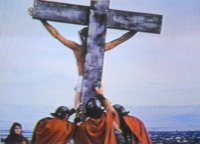 Following up Tuesday's review of The Gospel Road here is the scene guide for the film. Gospel citations follow the usual format. I should add that in writing this I realise there are a few areas I'm not entirely confident in, so apologies if there is the odd mistake.
Following up Tuesday's review of The Gospel Road here is the scene guide for the film. Gospel citations follow the usual format. I should add that in writing this I realise there are a few areas I'm not entirely confident in, so apologies if there is the odd mistake.Prophecy about Jesus - (Is 9:2)
The boy Jesus grows in stature - (Luke 2:51-52)
John the Baptist - (Mark 1:4-11)
Temptation of Jesus - (Matt 4:1-4)
Rejection at Nazareth - (Luke 4:16-30)
Wedding at Cana - (John 2:1-11)
Blind Man healed at Bethsaida - (Mark 8:22-25)
Calling of the 12 - (Mark 3:14-19)
Peter's Confession of Christ - (Mark 8:27-30)
Jesus the Way, Truth and Life - (John 14:6)
The truth sets you free - (John 8:32)
Good Shepherd - (John 10:1-18)
The Two Greatest Commandments - (Matt 22:34-40)
The Greatest Love - John 15:12-13)
John the Baptist doubts Jesus - (Matt 11:1-5)
Jesus ponders John's death - (Matt 14:10, 13a)
Clearing of the Temple - (John 2:14-22)*
Seven Woes - (Matt 23:1-36)
The Fulfilment of the Law - (Matt 5:17-18)
Rest for the Weary - (Matt 11:28-30)
Woman caught in Adultery - (John 8:2-11)
Jesus and Nicodemus - (John 3:1-16)
Sermon on the Mount - (Matt 5-7)Judging (Matt 7:1)
Eating with Sinners - (Mark 2:15-17)
Ask and receive (Matt 7:7)
Go the extra mile (Matt 5:40-42)
Giving Alms (Matt 6:3-4)
Do not Worry (Matt 6:28-31)
Seek first the kingdom (Matt 6:32)
Beatitudes (Matt 5:1-12)
Lord's prayer (Matt 9:9-14)
History of Mary Magdalene - (Luke 8:2)
Jesus and children - (Mark 10:14-15)
Jesus weeps - (John 11:35)
Passion prediction - (Mark 8:32)
Apocalyptic discourse - (Mark 13:4-8,13,21-22)
New commandment - (John 13:34-5)
Gospel preached to all people - (Matt 24:14)
Time of the Parousia - (Mark 13:31-32)
Kingdom not of this world - (John 18:36)
Triumphal Entry - (Luke 19:35-41)
Clearing of the Temple - (Mark 11:12-18)
Taxes to Caesar - (Mark 12:13-17)
Last Supper - (Mark 14:12-23)
Gethsemane - (Mark 14:32-40)
Trials - (Luke 22:54-23:25)
Mocking and Beating - (Mark 15:15-20)
Road to the Cross - (Luke 23:27)
Crucifixion - (Mark 15:22-26)
2 Thieves - (Luke 23:39-43)
Jesus's Death - (Mark 15:33-41)
Mary sees the risen Jesus - (John 20:11-18)
Appearance to disciples - (John 21:9-12)
Great Commission - (Matt 28:16-20)
A Few Notes
 This is the only film that shows Jesus clearing the temple twice. This is based on a very conservative view of scripture which deduces that since John includes the incident that the start of his gospel, in contrast to the story's location at the end of the synoptic gospels, that the incident must have occurred twice. It is noticeable how different details are emphasised in both scenes to bolster the idea that there were originally two different incidents.
This is the only film that shows Jesus clearing the temple twice. This is based on a very conservative view of scripture which deduces that since John includes the incident that the start of his gospel, in contrast to the story's location at the end of the synoptic gospels, that the incident must have occurred twice. It is noticeable how different details are emphasised in both scenes to bolster the idea that there were originally two different incidents.This is one of the strangest versions of the Sermon on the Mount. As noted in my review Cash and Elfstrom had such a low budget that when a scene called for a multitude they had Jesus on his own. This effect is used here. Jesus stands on various locations on a huge hill, but utterly alone. This technique does serve to emphasise the universality of Jesus's teaching, as he stands on top of the hill addressing the whole universe.
It is also strange because, unlike the majority of depictions of the Sermon on the Mount (not least the one in Matthew's Gospel), it does not start with the Beatitudes, but only introduces them part way through.
The depiction of the Lord's Prayer is also interesting concluding, as it does, the Sermon on the Mount. Here the camera moves to Cash who prays the prayer with the bible half open. However, the final stanza of the version of the Lord's prayer recited in churches is not actually found in the gospels, at least not in the majority of texts, only in a few of the later texts. So when Cash gets to this part of the prayer he very subtly closes his bible, marking the transition between the Jesus of history and the Christ of faith, which occurs throughout the film.
 Finally, as you may have noted from the length of this scene guide for an 83 minute film, the film includes a great number of Jesus's individual sayings, many of which are just the famous bits plucked out of their "original", longer context. I will write more about this aspect later.
Finally, as you may have noted from the length of this scene guide for an 83 minute film, the film includes a great number of Jesus's individual sayings, many of which are just the famous bits plucked out of their "original", longer context. I will write more about this aspect later.
No comments:
Post a Comment